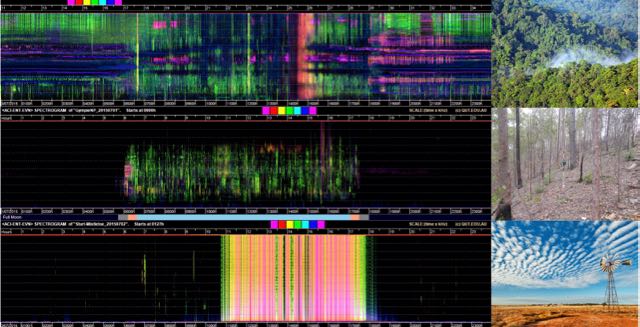A magazine where the digital world meets the real world.
On the web
- Home
- Browse by date
- Browse by topic
- Enter the maze
- Follow our blog
- Follow us on Twitter
- Resources for teachers
- Subscribe
In print
What is cs4fn?
- About us
- Contact us
- Partners
- Privacy and cookies
- Copyright and contributions
- Links to other fun sites
- Complete our questionnaire, give us feedback
Search:
Dawn Chorus Soundscapes
by Michael Towsey, Queensland University of Technology

Recordings of natural sounds are an important way that ecologists monitor the health of the environment and biodiversity. But it is now possible to record so much that the scientists just don't have time to listen to it all. The solution our team at Queensland University of Technology have been exploring is to turn the sound into pictures, called 'false-colour spectrograms', that help make the interesting features jump out. Our algorithms pull out sections of the recordings based on statistics about where the sound energy is. They then automatically colour graphs of this sound distribution to highlight features like rain storms or the dawn chorus. These features can then be examined through months or even years of recordings.
The image here is a set of three false-colour spectrograms of the winter sound-scape in three different parts of the world, as shown in the three pictures below. Each starts at midnight and ends the following midnight with midday in the centre. All three recordings were made in the first week of July 2015. The top recording is from a tropical rainforest in Papua New Guinea. The middle one is made in a dry forest north of Brisbane, Australia. The bottom recording was made in semi-desert in north-west New South Wales, Australia.
These three soundscapes reflect the great differences in vegetation and animal life. The orange patch at 2:30pm in the first recording is a tropical rain shower. The yellow block in the middle of the last recording is due to high winds that sweep across the desert landscape as the temperature climbs. At night the desert temperatures can be below freezing. The morning chorus of birds in the dry forest is at about 6am. Can you see a morning chorus at the other sites? What animals do you think cause the night-time blue tracks in the first, tropical rain forest recording?
Spectogram Adelbert Range recording image courtesy of Eddie Game, The Nature Conservancy. The Gympie recording courtesy of Yvonne Philips, Queensland University of Technology (QUT). Sturt recording courtesy of Ecosounds.org. Spectrograms obtained from Michael Towsey, ecosounds.org, QUT.


